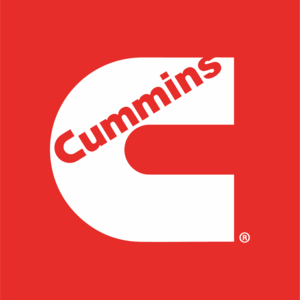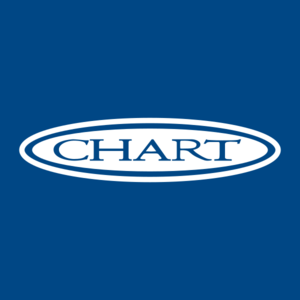
Proto Labs (PRLB)
We wouldn’t buy Proto Labs. Its poor sales growth shows demand is soft and its negative returns on capital suggest it destroyed value.― StockStory Analyst Team
1. News
2. Summary
Why We Think Proto Labs Will Underperform
Pioneering the concept of online quoting and manufacturing for custom prototypes and low-volume production parts, Proto Labs (NYSE:PRLB) offers injection molding, 3D printing, and sheet metal fabrication for manufacturers in various industries.
- Earnings per share have contracted by 8.7% annually over the last five years, a headwind for returns as stock prices often echo long-term EPS performance
- Negative returns on capital show that some of its growth strategies have backfired, and its decreasing returns suggest its historical profit centers are aging
- Poor expense management has led to an operating margin that is below the industry average


Proto Labs doesn’t pass our quality test. There are better opportunities in the market.
Why There Are Better Opportunities Than Proto Labs
High Quality
Investable
Underperform
Why There Are Better Opportunities Than Proto Labs
Proto Labs is trading at $53.53 per share, or 32.8x forward P/E. Not only is Proto Labs’s multiple richer than most industrials peers, but it’s also expensive for its revenue characteristics.
There are stocks out there featuring similar valuation multiples with better fundamentals. We prefer to invest in those.
3. Proto Labs (PRLB) Research Report: Q3 CY2025 Update
Manufacturing services provider Proto Labs (NYSE:PRLB) announced better-than-expected revenue in Q3 CY2025, with sales up 7.8% year on year to $135.4 million. The company expects next quarter’s revenue to be around $129 million, close to analysts’ estimates. Its non-GAAP profit of $0.47 per share was 19.9% above analysts’ consensus estimates.
Proto Labs (PRLB) Q3 CY2025 Highlights:
- Revenue: $135.4 million vs analyst estimates of $133.9 million (7.8% year-on-year growth, 1.1% beat)
- Adjusted EPS: $0.47 vs analyst estimates of $0.39 (19.9% beat)
- Adjusted EBITDA: $21.13 million vs analyst estimates of $18.9 million (15.6% margin, 11.8% beat)
- Revenue Guidance for Q4 CY2025 is $129 million at the midpoint, roughly in line with what analysts were expecting
- Adjusted EPS guidance for Q4 CY2025 is $0.34 at the midpoint, above analyst estimates of $0.33
- Operating Margin: 6.5%, in line with the same quarter last year
- Free Cash Flow Margin: 18.5%, similar to the same quarter last year
- Market Capitalization: $1.27 billion
Company Overview
Pioneering the concept of online quoting and manufacturing for custom prototypes and low-volume production parts, Proto Labs (NYSE:PRLB) offers injection molding, 3D printing, and sheet metal fabrication for manufacturers in various industries.
The company was originally founded as Protomold in 1999 but rebranded to Proto Labs in 2009 after launching a computer numerical control (CNC) machining service, or software that dictates the movement of factory tools and machinery. Under the new company name, it expanded its capabilities to include injection molding, 3D printing, and sheet metal fabrication.
Today, Proto Labs’s product offerings cater to manufacturing services in the automotive, aerospace, healthcare, consumer, and industrial sectors. The company provides rapid prototyping, on-demand production, and custom parts manufacturing. Its services help customers bring new products to market faster by offering quick-turn production of prototypes and low-volume production parts. Proto Labs also offers design feedback to help customers optimize parts for manufacturability, ultimately reducing costs and improving product quality.
The company allows customers to upload designs, receive quotes, and place orders on its digital platform. In terms of revenue generation, it engages in contracts including pricing agreements, volume commitments, and partnerships. Pricing can vary depending on order volumes and frequency, an approach instated to incentivize longer commitments and larger orders.
4. Custom Parts Manufacturing
Onshoring and inventory management–themes that grew in focus after COVID wreaked havoc on global supply chains–are tailwinds for companies that combine economies of scale with reliable service. Many in the space have adopted 3D printing to efficiently address the need for bespoke parts and components, but all companies are still at the whim of economic cycles. For example, consumer spending and interest rates can greatly impact the industrial production that drives demand for these companies’ offerings.
Competitors offering similar products include Cimpress (NASDAQ:CMPR), Stratasys (NASDAQ:SSYS), and Xometry (NASDAQ:XMTR).
5. Revenue Growth
A company’s long-term performance is an indicator of its overall quality. Any business can put up a good quarter or two, but the best consistently grow over the long haul. Regrettably, Proto Labs’s sales grew at a sluggish 3.3% compounded annual growth rate over the last five years. This fell short of our benchmark for the industrials sector and is a tough starting point for our analysis.
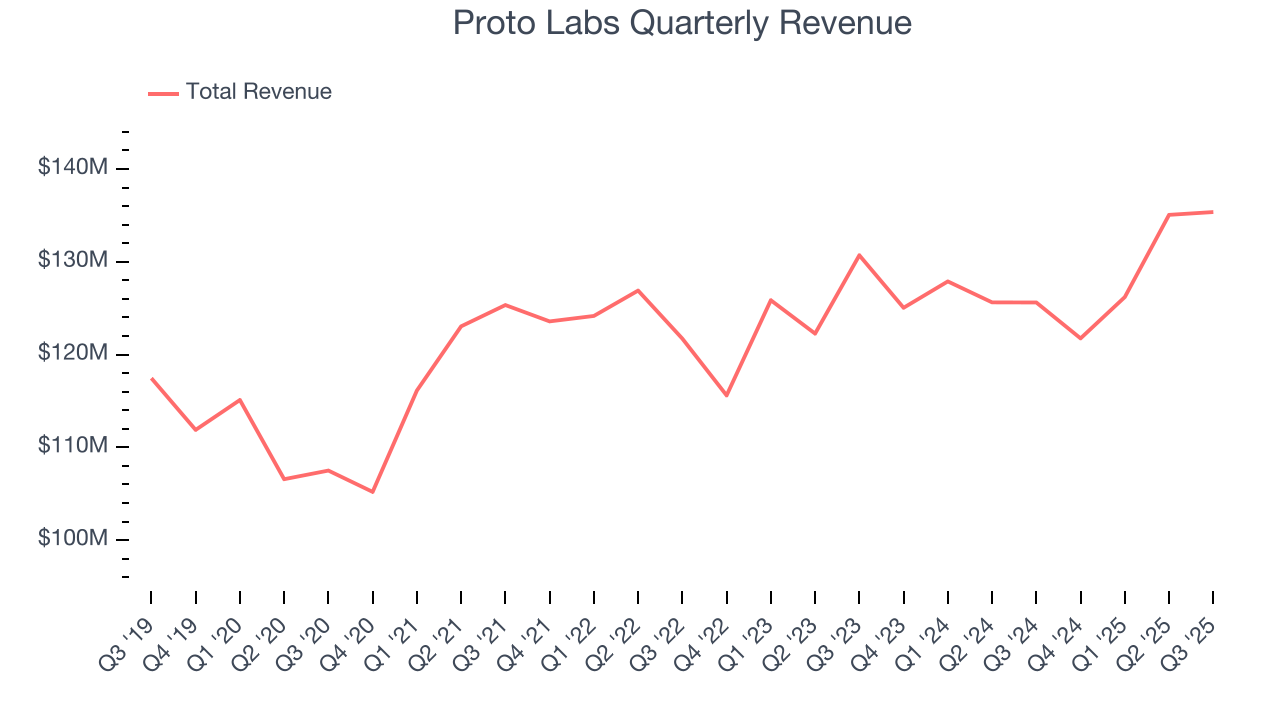
We at StockStory place the most emphasis on long-term growth, but within industrials, a half-decade historical view may miss cycles, industry trends, or a company capitalizing on catalysts such as a new contract win or a successful product line. Proto Labs’s annualized revenue growth of 2.4% over the last two years aligns with its five-year trend, suggesting its demand was consistently weak. 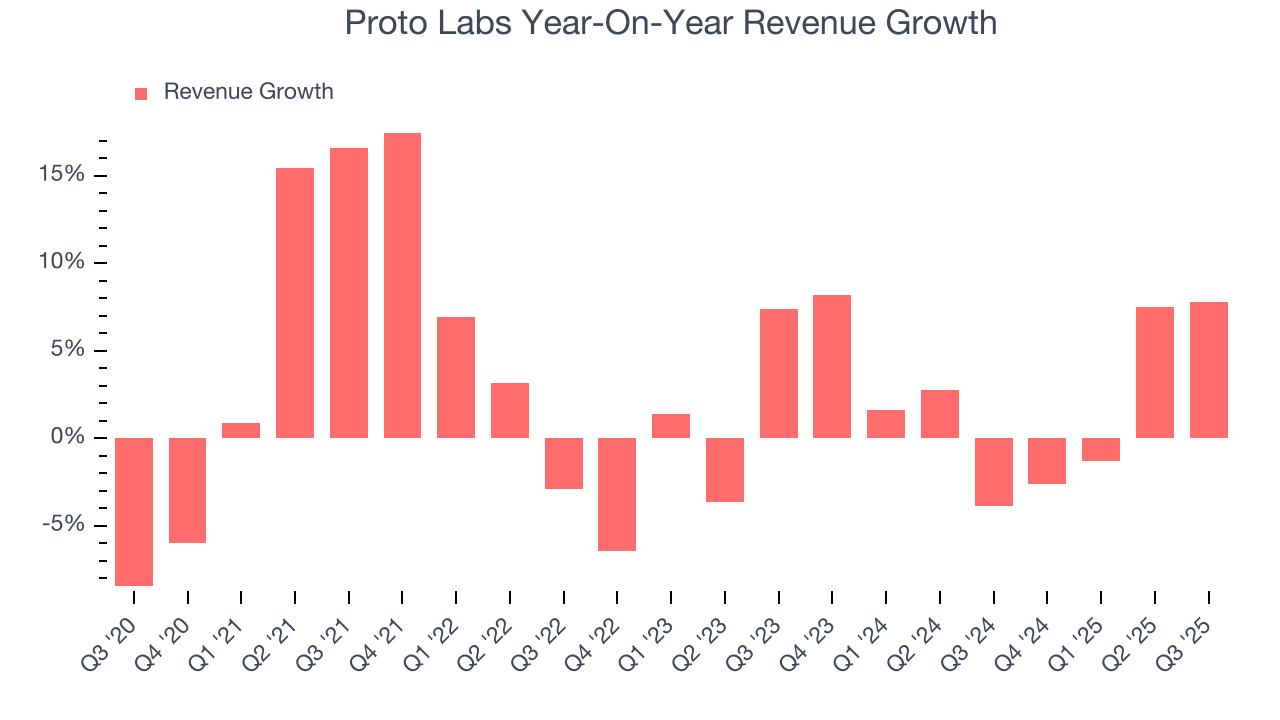
We can dig further into the company’s revenue dynamics by analyzing its three most important segments: Injection Molding , CNC Machining , and 3D Printing, which are 35.3%, 46.6%, and 14.8% of revenue. Over the last two years, Proto Labs’s CNC Machining revenue (custom CNC-machined parts) averaged 8.5% year-on-year growth while its Injection Molding (injection molds and parts) and 3D Printing (custom 3D-printed parts) revenues averaged 1.6% and 1.4% declines. 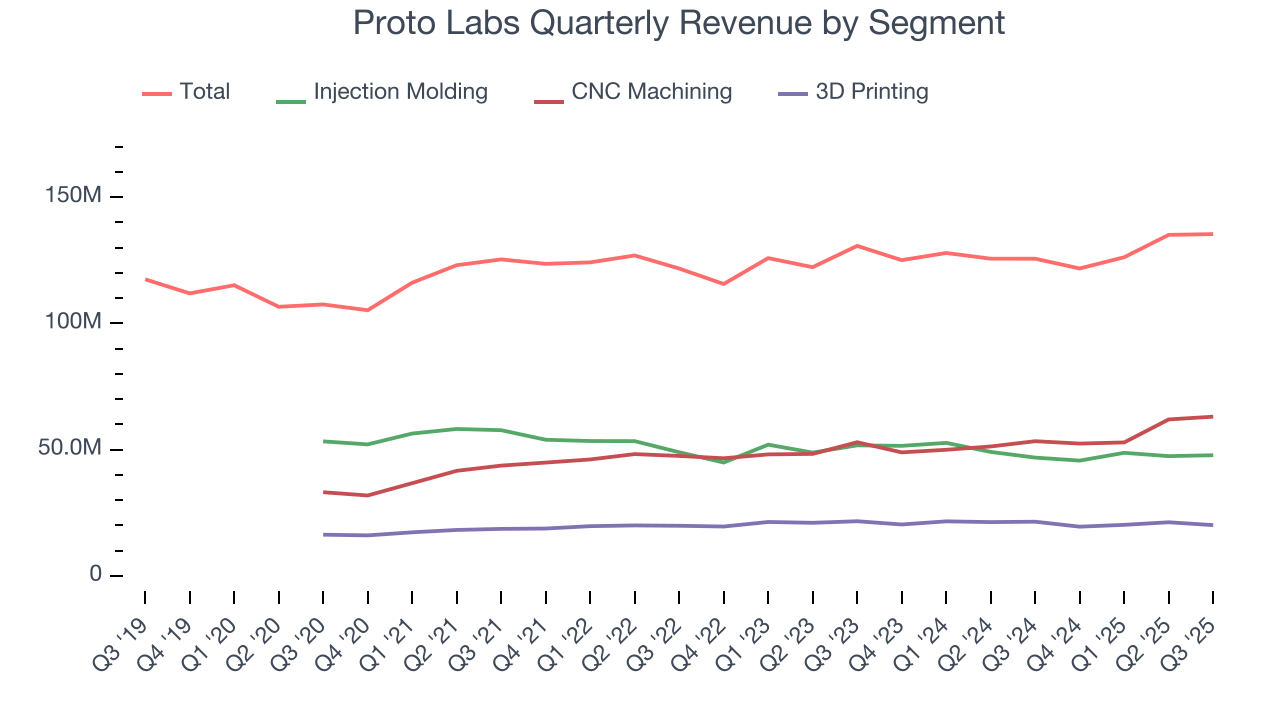
This quarter, Proto Labs reported year-on-year revenue growth of 7.8%, and its $135.4 million of revenue exceeded Wall Street’s estimates by 1.1%. Company management is currently guiding for a 6% year-on-year increase in sales next quarter.
Looking further ahead, sell-side analysts expect revenue to grow 4.8% over the next 12 months. While this projection implies its newer products and services will spur better top-line performance, it is still below the sector average.
6. Gross Margin & Pricing Power
Cost of sales for an industrials business is usually comprised of the direct labor, raw materials, and supplies needed to offer a product or service. These costs can be impacted by inflation and supply chain dynamics.
Proto Labs has best-in-class unit economics for an industrials company, enabling it to invest in areas such as research and development. Its margin also signals it sells differentiated products, not commodities. As you can see below, it averaged an elite 44.8% gross margin over the last five years. Said differently, roughly $44.81 was left to spend on selling, marketing, R&D, and general administrative overhead for every $100 in revenue. 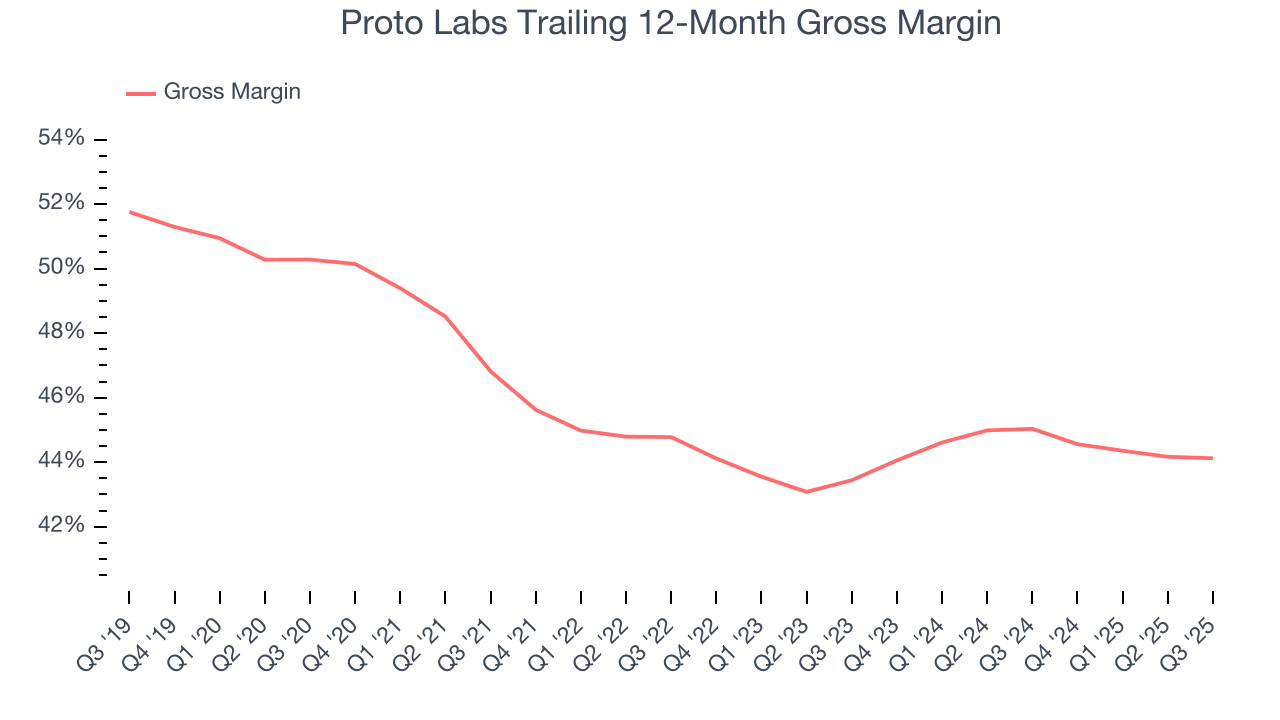
Proto Labs produced a 45.3% gross profit margin in Q3, in line with the same quarter last year. On a wider time horizon, the company’s full-year margin has remained steady over the past four quarters, suggesting its input costs (such as raw materials and manufacturing expenses) have been stable and it isn’t under pressure to lower prices.
7. Operating Margin
Proto Labs was roughly breakeven when averaging the last five years of quarterly operating profits, inadequate for an industrials business. This result is surprising given its high gross margin as a starting point.
Looking at the trend in its profitability, Proto Labs’s operating margin decreased by 4.9 percentage points over the last five years. This raises questions about the company’s expense base because its revenue growth should have given it leverage on its fixed costs, resulting in better economies of scale and profitability. Proto Labs’s performance was poor no matter how you look at it - it shows that costs were rising and it couldn’t pass them onto its customers.
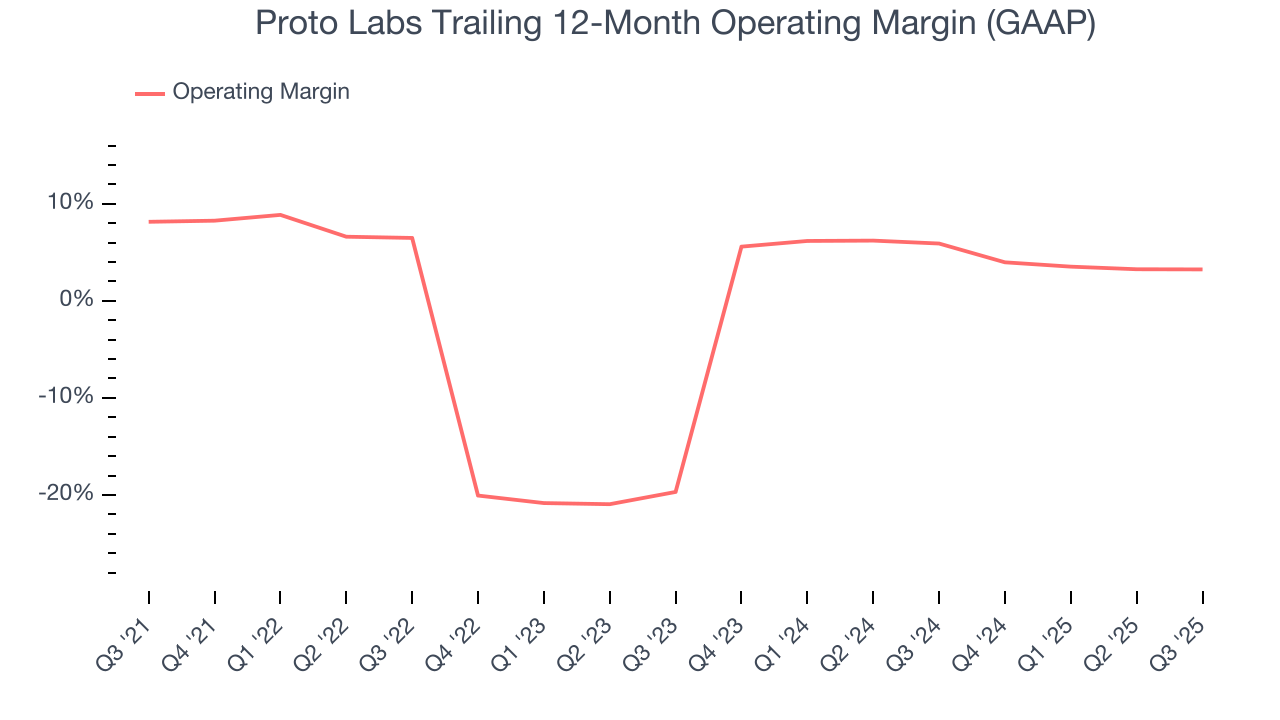
In Q3, Proto Labs generated an operating margin profit margin of 6.5%, in line with the same quarter last year. This indicates the company’s cost structure has recently been stable.
8. Earnings Per Share
We track the long-term change in earnings per share (EPS) for the same reason as long-term revenue growth. Compared to revenue, however, EPS highlights whether a company’s growth is profitable.
Sadly for Proto Labs, its EPS declined by 8.7% annually over the last five years while its revenue grew by 3.3%. This tells us the company became less profitable on a per-share basis as it expanded due to non-fundamental factors such as interest expenses and taxes.
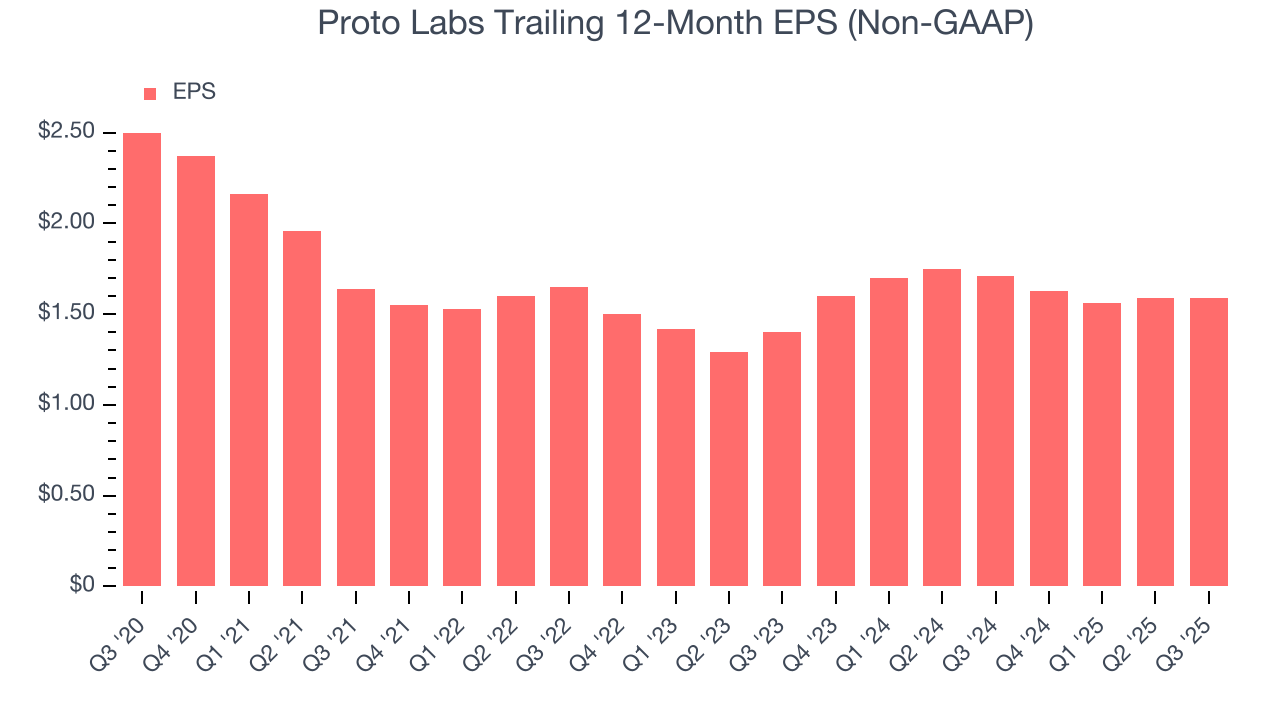
We can take a deeper look into Proto Labs’s earnings to better understand the drivers of its performance. As we mentioned earlier, Proto Labs’s operating margin was flat this quarter but declined by 4.9 percentage points over the last five years. This was the most relevant factor (aside from the revenue impact) behind its lower earnings; interest expenses and taxes can also affect EPS but don’t tell us as much about a company’s fundamentals.
Like with revenue, we analyze EPS over a shorter period to see if we are missing a change in the business.
For Proto Labs, its two-year annual EPS growth of 6.6% was higher than its five-year trend. Accelerating earnings growth is almost always an encouraging data point.
In Q3, Proto Labs reported adjusted EPS of $0.47, in line with the same quarter last year. This print easily cleared analysts’ estimates, and shareholders should be content with the results. Over the next 12 months, Wall Street expects Proto Labs’s full-year EPS of $1.59 to stay about the same.
9. Cash Is King
Free cash flow isn't a prominently featured metric in company financials and earnings releases, but we think it's telling because it accounts for all operating and capital expenses, making it tough to manipulate. Cash is king.
Proto Labs has shown robust cash profitability, enabling it to comfortably ride out cyclical downturns while investing in plenty of new offerings and returning capital to investors. The company’s free cash flow margin averaged 9.8% over the last five years, quite impressive for an industrials business. The divergence from its underwhelming operating margin stems from the add-back of non-cash charges like depreciation and stock-based compensation. GAAP operating profit expenses these line items, but free cash flow does not.
Taking a step back, we can see that Proto Labs’s margin expanded by 8.3 percentage points during that time. This is encouraging, and we can see it became a less capital-intensive business because its free cash flow profitability rose while its operating profitability fell.
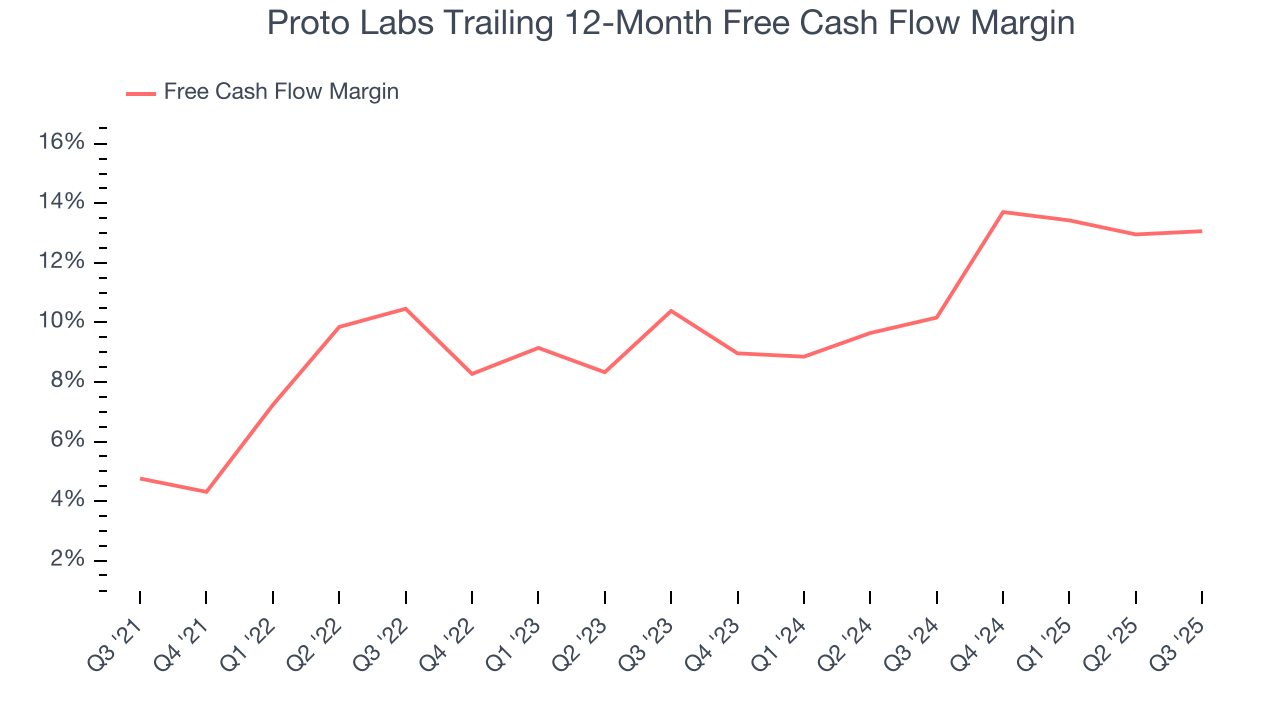
Proto Labs’s free cash flow clocked in at $25.03 million in Q3, equivalent to a 18.5% margin. This cash profitability was in line with the comparable period last year and above its five-year average.
10. Return on Invested Capital (ROIC)
EPS and free cash flow tell us whether a company was profitable while growing its revenue. But was it capital-efficient? Enter ROIC, a metric showing how much operating profit a company generates relative to the money it has raised (debt and equity).
Proto Labs’s five-year average ROIC was negative 1.3%, meaning management lost money while trying to expand the business. Its returns were among the worst in the industrials sector.
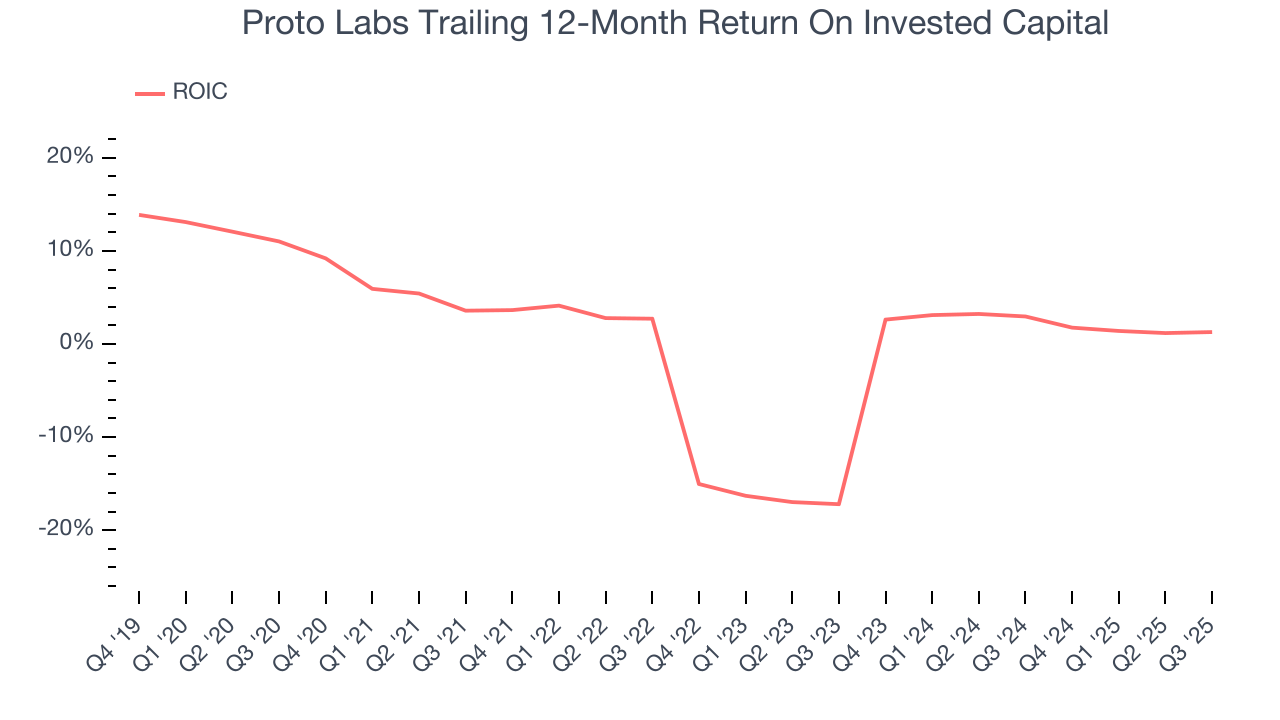
We like to invest in businesses with high returns, but the trend in a company’s ROIC is what often surprises the market and moves the stock price. Unfortunately, Proto Labs’s ROIC averaged 1 percentage point decreases over the last few years. Paired with its already low returns, these declines suggest its profitable growth opportunities are few and far between.
11. Balance Sheet Assessment
One of the best ways to mitigate bankruptcy risk is to hold more cash than debt.
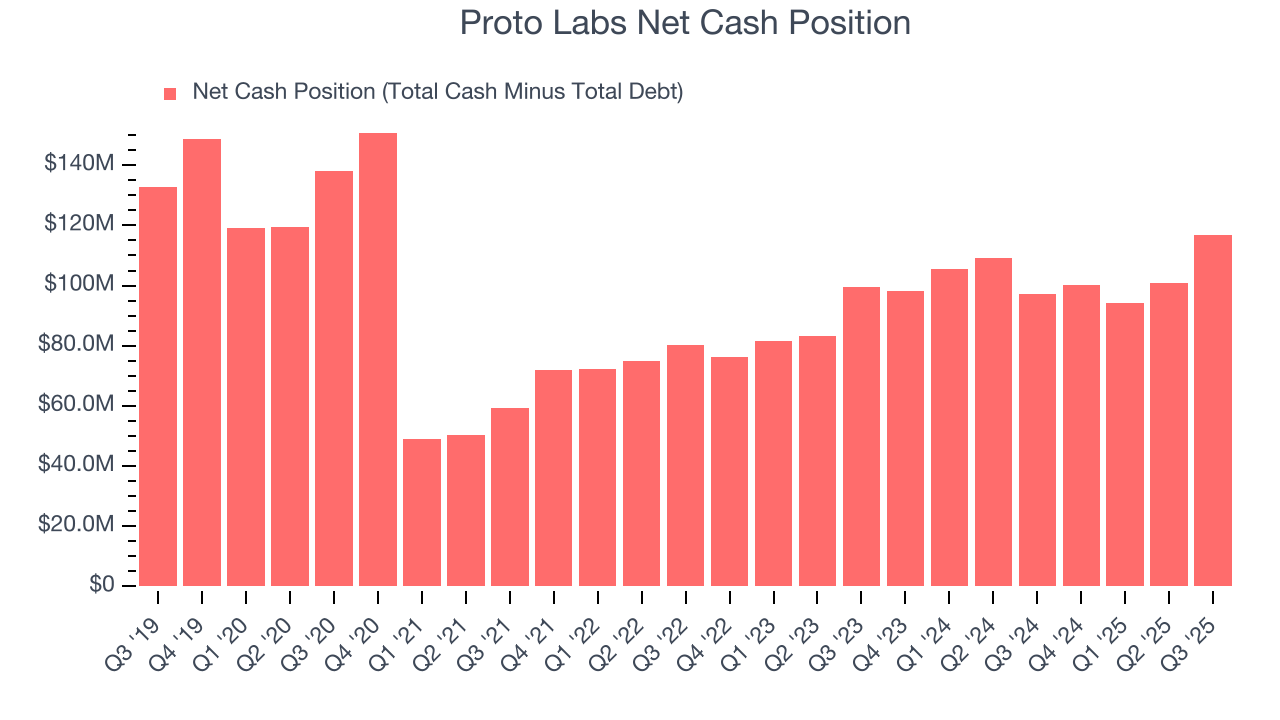
Proto Labs is a profitable, well-capitalized company with $119.2 million of cash and $2.44 million of debt on its balance sheet. This $116.8 million net cash position is 9.2% of its market cap and gives it the freedom to borrow money, return capital to shareholders, or invest in growth initiatives. Leverage is not an issue here.
12. Key Takeaways from Proto Labs’s Q3 Results
We liked that Proto Labs beat analysts’ revenue and EPS expectations this quarter. Q4 EPS guidance also came in ahead of Wall Street's estimates. Zooming out, we think this quarter featured some important positives. The stock traded up 1.7% to $54 immediately following the results.
13. Is Now The Time To Buy Proto Labs?
Updated: December 24, 2025 at 11:05 PM EST
Before making an investment decision, investors should account for Proto Labs’s business fundamentals and valuation in addition to what happened in the latest quarter.
Proto Labs doesn’t pass our quality test. To kick things off, its revenue growth was weak over the last five years. And while its rising cash profitability gives it more optionality, the downside is its relatively low ROIC suggests management has struggled to find compelling investment opportunities. On top of that, its declining EPS over the last five years makes it a less attractive asset to the public markets.
Proto Labs’s P/E ratio based on the next 12 months is 32.8x. This valuation tells us it’s a bit of a market darling with a lot of good news priced in - you can find more timely opportunities elsewhere.
Wall Street analysts have a consensus one-year price target of $56.67 on the company (compared to the current share price of $53.53).

